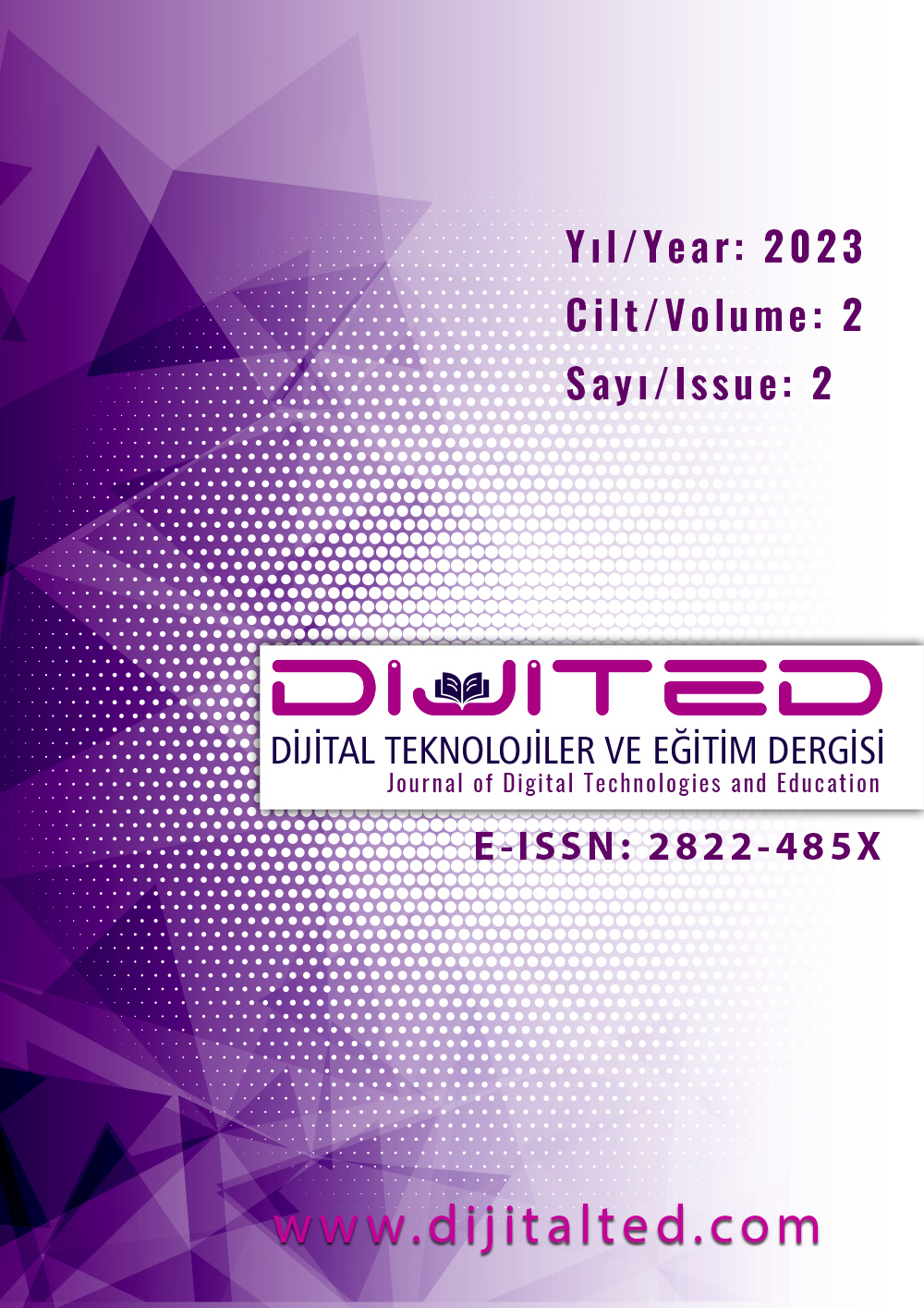Use of Interactive Digital Course Materials: A Research in the Field of Music Education
DOI:
https://doi.org/10.5281/zenodo.10439846Keywords:
Interactive Learning, Digital Course Material, Music EducationAbstract
This study emphasizes the importance of the design and use of interactive course materials in music education and suggests the use of such material as a form of improving learning processes. The study discusses how technology can be used to support student-centered learning by revealing the importance of educational technology and the role of technology in education. In the study where the sequential explanatory model, which is a mixed method, was used, quantitative and qualitative data collection methods were combined. While quantitative data was obtained through student opinions and achievement tests, qualitative data was collected through student interviews. An attitude scale and an achievement test were applied to the learning material, which are measurement tools. 30 high school students were randomly assigned to experimental and control groups. While the experimental group was provided with materials in accordance with e-learning principles, the control group was taught using the traditional method. The resulting findings include data obtained from statistical analyzes and interviews. Through measurement tools, it was determined how the participants reacted to e-learning course materials within the scope of music education. In analytical studies, analysis of variance was applied to control the change in group achievements. Although the pretest results were similar, it was determined that there was a significant difference between the experimental group and the control group in the posttest. The result in question shows that the experimental group made more progress compared to the control group. The evaluations of the students in the experimental group regarding the digital material give a result similar to the median score. In other words, it appears that they liked and adopted the material at an average level. These results show that the experimental group achieved more success than the control group and liked the digital material moderately. In semi-structured interviews, open-ended questions prepared in parallel with the quantitative analysis were asked to the focus group interview participants. Participants pointed out the difficulties in asking questions to teachers as negative aspects of digital material, and also stated that digital material has some boring aspects. The fact that the participants accept that digital materials have a place in education, as well as emphasizing the dominant qualities of face-to-face learning, clearly coincides with the issues that emerged as mainstream views in previous studies in the relevant literature.
References
Akarsu, S. (2017). Müzik Dersinde Öğrenme Öğretme Süreci ile İlgili Öğrenci Görüşleri. Journal of Turkish Studies. 12. 35-48. 10.7827/TurkishStudies.12690. https://www.researchgate.net/publication/322073619_MUZIK_DERSINDE_OGRENME_OGRETME_S URECI_ILE_ILGILI_OGRENCI_GORUSLERI
Akgün Özbek, E. (2016). Teknoloji eğitim için iyi midir? [Kitap tanıtımı: Is technology good for education by N. Selwyn], AUAd, 2(4), 177-185. https://dergipark.org.tr/tr/download/articlefile/402175
Aydın, C. H. (2000). Öğrenme ve öğretme kuramlarının eğitim iletişimine katkısı. Kurgu Anadolu Üniversitesi İletişim Bilimleri Fakültesi Uluslararası Hakemli İletişim Dergisi, 17(17), 183-197., https://dergipark.org.tr/tr/download/article-file/1501157
Bilgiç, E. Ş., (2005). “E-Öğretim Tasarım Süreci: Bir Materyalin Kullanışlılığına İlişkin Katılımcı Görüşleri”, Uzmanlık Yeterlilik Tezi, Türkiye Cumhuriyet Merkez Bankası İnsan Kaynakları Genel Müdürlüğü, Ankara: https://www3.tcmb.gov.tr/kutuphane/TURKCE/tezler/ecesenerbilgic.pdf Bozkurt, A. (2014). Ağ toplumu ve öğrenme: Bağlantıcılık, Mersin Üniversitesi, Akademik Bilişim’14 - XVI. Akademik Bilişim Konferansı Bildirileri, (Mersin:5 - 7 Şubat 2014). https://www.researchgate.net/publication/335723739_Ag_toplumu_ve_ogrenme_Baglanticilik
Bloom, Benjamin S. (1968). "Learning for Mastery". UCLA - CSEIP - Evaluation Comment. Vol. 1.
Cresswell, J. W., & Plano Clark, V. L. (2010). Designing and conducting mixed methods research. 2nd edn Sage Publications Inc. Thousand Oaks, CA.
Creswell, J. W. (1994). Research Design: Qualitative and Quantitative Approaches. Thousand Oaks, CA: Sage.
Dalmışlı, F. (2013). Müzik Eğitiminde Materyal Geliştirme. Yayınlanmamış Yüksek Lisans Tezi. Pamukkale Üniversitesi Eğitim Bilimleri Enstitüsü.
Deperlioğlu, Ö. (2010). Bölüm-6 E-öğrenme Sistemlerinde Verimliliğin Ölçülmesi: Afyon Kocatepe Üniversitesi Örneği. Türkiye’de e-öğrenme: gelişmeler ve uygulamalar, 131. https://www.researchgate.net/publication/342355053_TURKIYE_DE_EOGRENME_Gelismeler_ve_Uy gulamalar
Güneş, F. (2012). Bologna süreci ile yükseköğretimde öngörülen beceri ve yetkinlikler. Yükseköğretim ve Bilim Dergisi, (1), 1-9.
Güven, M. (2004). Öğrenme Stilleri ile Öğrenme Stratejileri Arasındaki İlişki. Eskişehir: Anadolu Üniversitesi Eğitim Bilimleri Enstitüsü, Yayımlanmış Doktora Tezi.
Güzeller, C., & Korkmaz, Ö. (2007). Bilgisayar Destekli Öğretimde Bir Ders Yazilimi Değerlendirmesi. Kastamonu Eğitim Dergisi, 15(1), 155-168. https://dergipark.org.tr/en/download/article-file/819232 Ilgın, S. (2022). “Tam Öğrenme Modeli”, Boğaziçi Enstitüsü, https://istanbulbogazicienstitu.com/tamogrenme-modeli-nedir
Kaya, Z. (2006). Öğretim teknolojileri ve materyal geliştirme. Pegem A Yayıncılık, Ankara.
Morgado, F.F.R., Meireles, J.F.F., Neves, C.M. et al. Scale development: ten main limitations and recommendations to improve future research practices. Psicol. Refl. Crít. 30, 3 (2018). https://doi.org/10.1186/s41155-016-0057-1
Parasız, G., & Aras, T. (2012). Teknolojinin Müzik ve Müzik Eğitimi Alanındaki Yeri ve Önemi. X. Ulusal Müzik Eğitimi Sempozyumu, 1107.
Rauter, E. A. (2011). Düzene uygun kafalar nasıl oluşturulur. Kaldıraç Yayınevi, İstanbul.
Uçak, N. Ö., & Çakmak, T. (2009). Web sayfası kullanılabilirliğinin ölçülmesi: Hacettepe Üniversitesi Bilgi ve Belge Yönetimi Bölümü web sayfası örneği. Türk kütüphaneciliği, 23(2), 278-298.
Yakut, M. (2019). Müzik öğretmenlerinin etkileşimli tahta kullanma durumlarının incelenmesi (Yüksek lisans tezi). T.C. Atatürk Üniversitesi Eğitim Bilimleri Enstitüsü Güzel Sanatlar Eğitimi Ana Bilim Dalı Müzik Eğitimi Bilim Dalı, Erzurum.
Yıldırım, O., & Şenyürek, E. (2010). İnsan bilgisayar etkileşimi. Ulusal Meslek Yüksekokulları Öğrenci Sempozyumu, (s. 1-10), Düzce.
Yıldız, G., & Demircioğlu, N. (1996). Müziğin eğitimdeki yeri. Kuram ve Uygulamada Eğitim Yönetimi Dergisi, 2(1), 150-152.
Downloads
Published
How to Cite
Issue
Section
License
Copyright (c) 2023 Dijital Teknolojiler ve Eğitim Dergisi

This work is licensed under a Creative Commons Attribution 4.0 International License.
- Abstract 756
- PDF (Türkçe) 36









